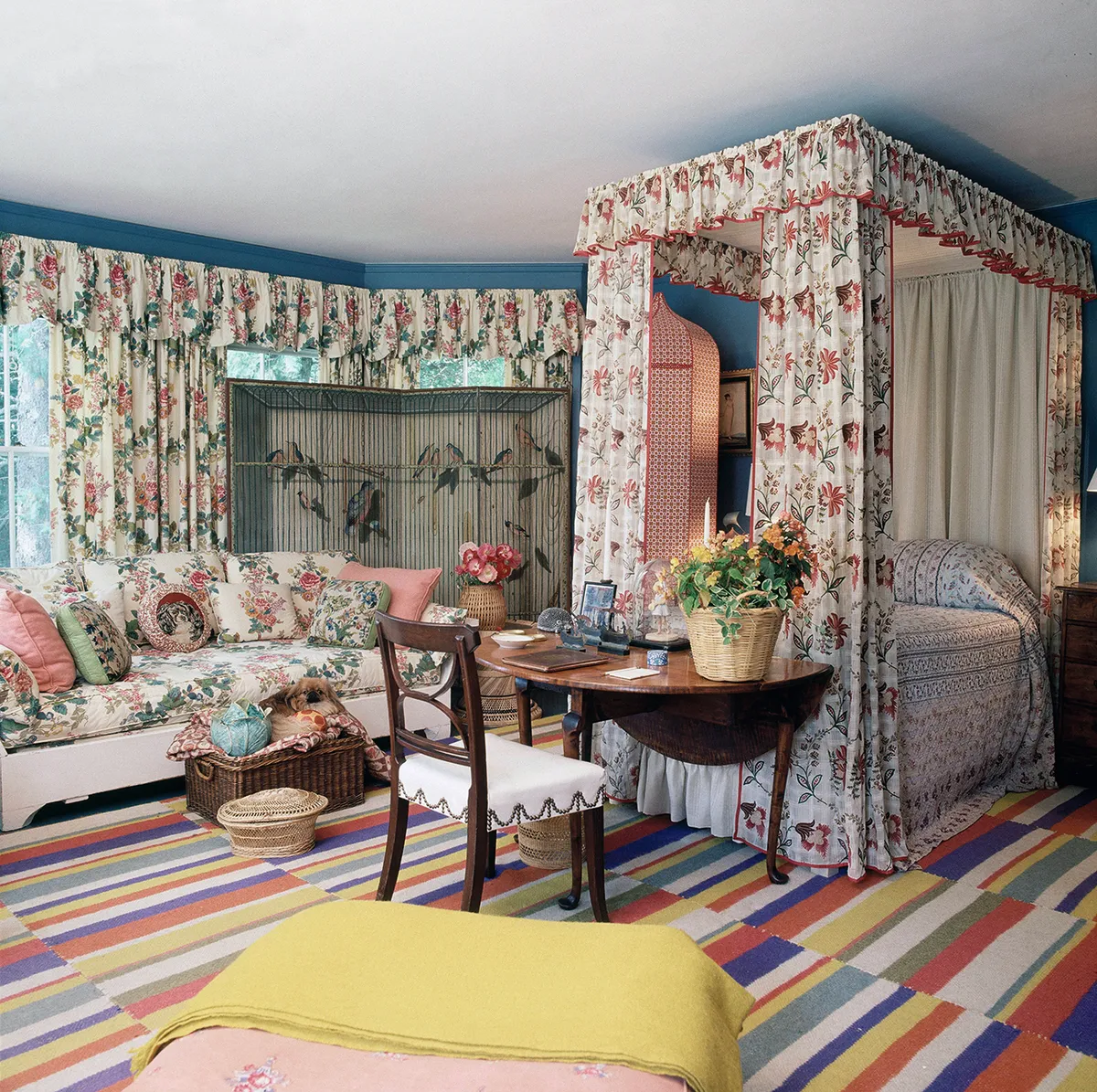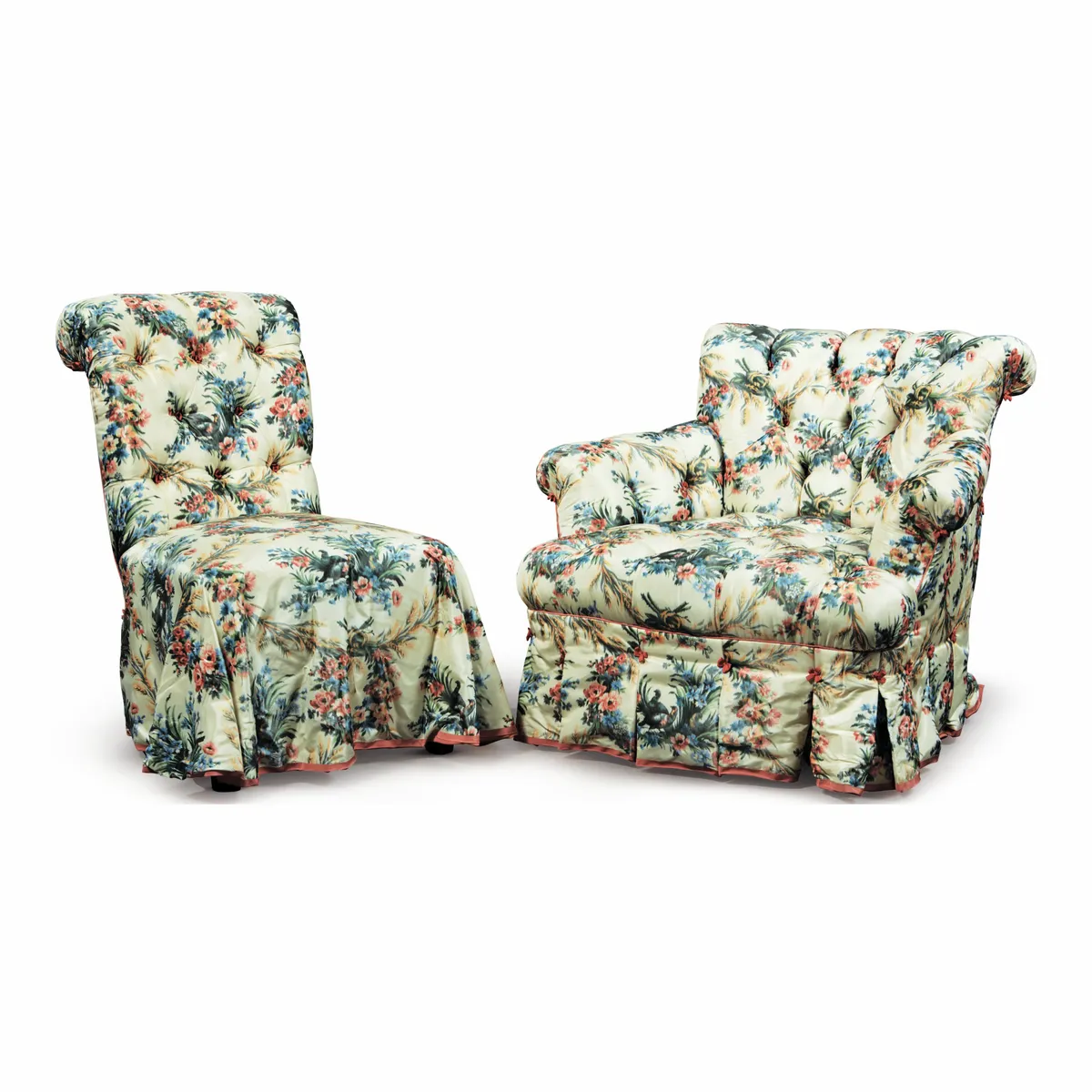Swagged, draped or ruched, chintz has been synonymous with English country house style since the mid 20th century. It fell out of favour over the last 20 years, but bold floral design is back again today, enjoying a tasteful revival. ‘There is a definite resurgence in interest in colour, pattern and layering as people have tired of minimalism,’ says artist and designer Luke Edward Hall. ‘There is a lot happening in the world that is pretty grim, so maximalism is a fantasy we can all escape into.’
What's the history of chintz?
Chintz has gone in and out of fashion for centuries. In recent times, its popularity waned with Ikea’s ‘Chuck Out Your Chintz’ ad campaign in 1996, but today it is being embraced again. Sally-Anne Huxtable, Head Curator at the National Trust, agrees there is something joyful and nostalgic about chintz that we seek when times have been hard. ‘The revival in England coincides with periods of austerity. We see it return after the First World War and then again in the 1940s after the Second World War. There is something comfortable and homely about it.’
How to identify a chintz design
As with many types of cotton fabrics, the story of chintz begins in India. In the past century or so chintz has come to mean any floral printed furnishing fabric, but originally it was a beautiful Indian technique of hand-drawing and dyeing fabric. The word ‘chintz’ is derived from the Hindi word chīnt, meaning to sprinkle or spray. Portuguese explorer Vasco da Gama brought vibrant textiles back from India along with spices after he reached Calicut (now Kozhikode) in 1498. Europeans, used to humble wool, linen and hemp, were mesmerised. When trading routes were established around 1600 and European East India Companies formed, an obsession began for these ‘Indiennes’. ‘It was another craze, much like tulip mania,’ says Sally- Anne. ‘Chintz mania was a thing among the European upper classes in the 17th and early 18th centuries. You would cover every surface in it and wear it.’

Designer profile: Luke Edward Hall
‘I really love chintz fabric. We moved to the countryside last summer and I’ve used more chintz in our home. I really love finding old chintz. I’m sourcing a lot on eBay, especially 1980s and 1990s designs by Laura Ashley, Sanderson and Colefax and Fowler. I use it mostly for curtains. I found a 15m roll of vintage chintz on eBay that I’m using for the spare bedroom. It’s a pale blue stripe with huge dahlias and I’ve designed the room around it. I’ve used it for blinds and lampshades.I’ve always loved the old-fashioned fabrics. When we had a flat in London, the chintz never reallyworked, but it really does in countryside interiors. It feels informal and traditionally linked to the country. You can echo the flowers growing in your garden inside your home.I’m greatly inspired by John Fowler and Mario Buatta. They’re the main guys when it comes to chintz. John Fowler was the pioneer of using it and taking it over to America. I love the classic English country house look. It works just as well in a small country cottage these days. It was once seen as unfashionable and twee, so vintage examples are really good value, which is what we love about it. Jean Monro chintzes are great if you’re looking for new fabric. I love the foxgloves design, it’s beautiful.’
Millions of tonnes of chintz were being imported to Britain by the 1660s. In 1663, Samuel Pepys bought chintz for his wife’s study while, decades later, Queen Anne decorated with it. The demand greatly impacted European textile manufacturers, however, and chintz was banned in France between 1686 and 1759, and partially banned in Britain between 1700 and 1774. ‘The ban really raised its cachet in some way,’ says Sally-Anne. ‘Thomas Chippendale was smuggling chintz in for Nostell Priory in the 1760s.’
The development of printed textile design in Europe made great leaps in 1752 when Irishman Francis Nixon invented the copper plating technique that made it easier to print large, detailed repeat patterns. Chintz could now be copied and produced at home. The Britishno longer needed to depend on Indian cotton manufacturers andinstead looked to the US and its emerging plantations.
By Victorian times, chintz bore little relation to its Indian original, as it had become a fussy, mass- produced, cheap imitation, so much so that in 1851 George Eliot coined what would became the pejorative term ‘chintzy’ in a letter to her sister giving her opinion on some fabrics. In reaction to the gaudy, glazed version printed with machinery and synthetic dyes in the 1850s, William Morris and other Arts and Crafts designers produced chintz that was more subtle and tasteful, made by hand with natural dyes. ‘It was anti-chintz chintz,’ says Sally-Anne.
Who were the key chintz designers?
Chintz came back to the fore in the 1920s when people looked for comfort in the interwar years. It dominated ceramics this time, with twee patterns evoking English cottage gardens adorning cups and teapots. But it was the 1940s that witnessed the most defining moment for chintz when John Fowler teamed up with Sibyl Colefax and her decorating firm to become Colefax & Fowler, creating glamorous interiors swathed in floral designs for an elite clientele. Fowler also worked on numerous National Trust properties after the war, including Clandon Park, Sudbury Hall and Uppark.
‘Fowler is responsible for this contemporary notion of the English country house style,’ says Sally-Anne. ‘He invented the whole idea of it. It’s actually quite an American vision of Englishness. In the States it became a sign of class and Anglophilia – a conservative American identity.’

American heiress Nancy Lancaster bought Colefax & Fowler and established a working relationship with Sister Parish Design in New York. In the 60s, Jackie Kennedy decorated with chintz in the family quarters of the White House, and in the 80s Nancy Reagan followed suit.The American interior decorator Mario Buatta, strongly influenced by John Fowler, fully embraced the style in the 1980s and became known as the Prince of Chintz. While Laura Ashley was the high-street brand everyone could visit in the UK,Jean Monro started a company reproducing high-end English chintzes at that time, and they’re still being produced today.
This summer, Colefax and Fowler is launching new colours for its iconic Bowood chintz (based on a design discovered by Fowler at Bowood House in Wiltshire in the 1950s), while homeware brands such as House of Hackney are designing contemporary chintz for a new generation. Frieda Gormley, director and founder of House of Hackney, says she started her company with her husband Javvy because they were bored of living in a ‘clinical white box’. ‘Over the last few years, we’ve seen more and more people moving away from minimalism and magnolia walls, and towards interiors that embrace colour and pattern while evoking a glorious nostalgia,’ she says. ‘The connotations of chintz as being fussy are now forgotten: people are falling in love with it all over again and deservedly so, as it beautifully brings the past into the present and imbues the home with a charming elegance and irresistible painterly colour.’
Buyers guide: antiques dealer and interior designer Jack Brister of Tradchap in Somerset on buying chintz
‘Vintage and antique chintzes have become highly sought after recently, so can be difficult to come by. Lots of chintz is coming out of big townhouses in London and Bath as the interiors are updated. It means more people can afford the chintz look as it is so much cheaper second-hand. The price is reasonable compared to what you would pay for new chintz today. Famous vintage designs by firms such as Colefax and Fowler,GP & J Baker and Warner & Ramm can be found at auction.
‘Like with anything second-hand, you should take a good look at it first before you commit to buying. Look for major damage or staining.It can sometimes be faded and holey but the imperfections are part of its charm – worn and lived in. Curtains are often far too long but I like that puddled look on the floor. Lamps are a good seller. They can go into any room, no matter what type of house you have. Furniture upholstered in chintz is more of a statement.
‘When planning a room, I try to find the curtains first. You can then work with the colours, otherwise you might never find the curtains to fit the room! Second-hand chintz curtains can cost about £250-£400 – just think how much they would have cost when they were made new.’
